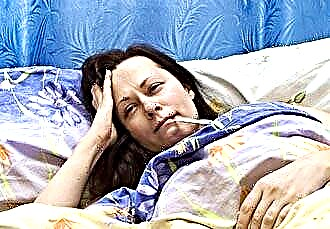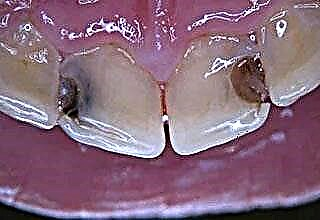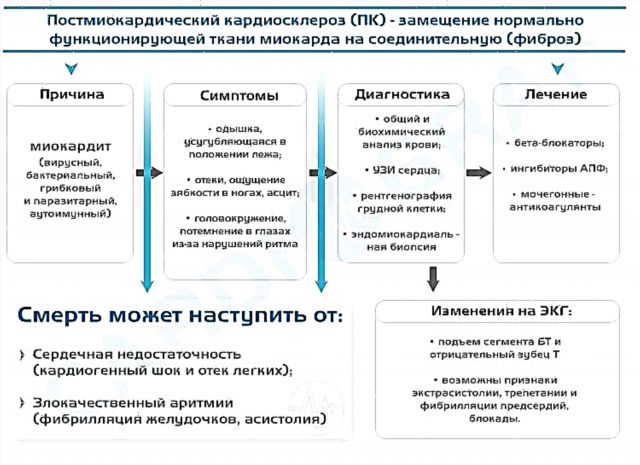Sore throat accompanying fever is a symptom familiar to both adults and children. Most often it is bilateral, however, the likelihood of pain on one side is not excluded. The intensity of pain also differs - the pain can be barely noticeable and not bother the patient or manifests itself very brightly, in some cases it makes it difficult not only to swallow and talk, but even to open the mouth. With any variant of pain and fever, adequate therapy is needed, for the selection of which it is necessary, first of all, to establish the cause of the pain and increase in body temperature. Treatment is aimed at eliminating the etiological (causal) factor and relieving the main symptoms.
Choice of treatment
 When does a sore throat appear against a background of increased body temperature? There are many pathologies that are characterized by these symptoms, but the most common are:
When does a sore throat appear against a background of increased body temperature? There are many pathologies that are characterized by these symptoms, but the most common are:
- ARVI (acute respiratory viral infection).
- Acute bacterial pharyngitis.
- Acute bacterial tonsillitis (tonsillitis).
- Acute laryngitis.
Fever is observed in the classic course of all of these diseases. However, with ARVI, it can respond to both subfebrile values (from 37.1 to 37.9 ° C) and febrile values (38–38.9 ° C). The acute course of bacterial pharyngitis and tonsillitis is characterized by an increase in temperature to febrile and even pyretic (39.1–41 ° C) values. In some cases, with each of the pathologies mentioned, hyperpyrexia is possible (an increase in body temperature over 41 ° C). At the same time, in acute laryngitis (inflammation of the mucous membrane of the larynx), there may be no fever at all - if it is present, then, as a rule, it is subfebrile.
A sore throat associated with fever is not a specific symptom of any particular medical condition.
Pain syndrome reflects the presence of an inflammatory process - like fever, it belongs to the standard "indicators" of pathological changes in the mucous membrane of the oropharynx, tonsils and larynx. Pain and febrile reaction are symptoms that can serve as criteria for assessing the condition, but require clarification of the diagnosis in order to provide proper care. If the patient has a sore throat and the temperature is higher than normal, you need to know what pathology we are talking about in order to effectively influence the manifestations of the disease.
Treatment tactics
When the temperature is 37, the throat hurts - what to do? What to do if temperature values exceed subfebrile values? Various methods of treatment are used, and the medicinal effect is necessarily combined with non-medicinal methods - including the correction of the regimen. The recommendations presented in the list below are relevant for all variants of the diseases mentioned in the previous section:
- Bed rest during fever.

When the body temperature rises, it is better for the patient to rest by staying in bed. This allows you to achieve several goals at the same time: to speed up the recovery period, to prevent dangerous complications and the spread of infection. It should be borne in mind that with fever, the functional load on all organs and systems increases.
- Plentiful warm non-alcoholic drink.
Drinking liquid (water, tea, compote) is a way of detoxification; in addition, if the patient drinks enough, mucus does not dry out, sputum is easier to cough up. The pain also decreases.
- Sparing regime.
It includes a diet (refusal from spicy, salty, crumbling foods), exclusion of smoking and drinking alcohol, and with laryngitis - additionally strict vocal rest (constant silence). You cannot use a whisper; if necessary, it is better to speak very quietly, for a limited time. Attention is also drawn to the temperature of the food and drink consumed (only warm, not hot and not cold), the consistency of food (liquid or semi-liquid, without solid components - for example, fish bones). It is better to avoid inhaling too cold or hot air, including sudden changes in its temperature.
- Control of microclimate parameters.
In dry and hot air, mucus dries quickly, forming crusts that make it difficult to breathe. The pain syndrome is also aggravated. Drafts are undesirable, but the room should be ventilated (in the absence of the patient), and the temperature and humidity should correspond to values in the range of 19-22 ° C and 50-70%, respectively.
- Thermal regime.
With a sore throat and high body temperature, the body needs to eliminate excess heat energy. The patient should be dressed warmly in the winter, lightly in the hot period. But at the same time, you should not wrap yourself up, cover the entire surface of the body with dense blankets, use thermal procedures (hot baths, steam inhalations).
Rubbing with alcohol is contraindicated for fever, especially if the patient is a child.
How to treat diseases with a lesion of the throat? Patients may be prescribed such therapy options as:
- antibacterial;
- anti-inflammatory;
- symptomatic.
Depending on the type of pathology and the general condition of the patient, these types of treatment are combined. The need for a particular method of exposure is determined by the doctor after an internal examination of the patient, assessment of complaints and objective changes.
Antibacterial therapy
The indication for the appointment of antibiotics is sometimes considered the presence and numbers of fever, which is not always correct. A febrile reaction is a manifestation of immune reactivity, that is, the response of the immune system to an invasion of the body by a pathogenic agent. A temperature of 39 ° C can be observed not only with bacterial, but also with viral infection (ARVI) - in the second case, antibiotics are not needed if there are no signs of attachment of a secondary, already microbial flora.
Contrary to popular belief, antibiotic therapy does not reduce the likelihood of microbial complications of a viral infection. It creates an excessive drug load and often contributes to the formation of resistance (resistance) to antibiotics - if used incorrectly, in fragmentary incomplete courses.
When is antibiotics needed? This question remains key in the primary diagnosis of diseases accompanied by pain in the throat. Rapid tests for detecting streptococcal infection are certainly useful, since it is beta-hemolytic streptococcus that is the most significant causative agent of pharyngitis and tonsillitis. However, in many medical institutions this method is not available, as well as an immediate study of peripheral blood (the presence of leukocytosis with a shift to the left and an increase in ESR can help in the differentiation of bacterial and viral infections).
 The need for antibiotic therapy is thus determined by objective clinical signs:
The need for antibiotic therapy is thus determined by objective clinical signs:
- Very bad sore throat.
- Temperature of 38 ° C or more, persisting for more than 3 days.
- The presence of whitish-yellow dots on the surface of the tonsils, plaques in the form of "islands", films.
Films are characteristic of lacunar sore throat - they do not spread beyond the amygdala; when they are removed, the mucous membrane does not bleed. This is an important differential sign that distinguishes banal (classic bacterial) angina from diphtheria, in which antibiotic therapy cannot be dispensed with and there is a threat of respiratory failure (diphtheria croup).
Streptococcal sore throat is an absolute indication for the use of antibacterial drugs.
For streptococcal lesions of the pharynx (pharyngitis) and tonsils (tonsillitis), as well as for other bacterial infections of the pharynx, tonsils and larynx, antibiotics from the group of penicillins (Amoxicillin), cephalosporins (Cephalexin, Cefuroxime) and macrolides (Azithromycin) are used.
Antibiotics for patients with laryngitis are prescribed with a significant deterioration in the general condition, severe fever. In the absence of an increase in body temperature, only local therapy is usually used.
Anti-inflammatory therapy
The intensity of the pain depends on the type and extent of the inflammatory process. To help the patient, means are needed that reduce his activity and help restore the affected mucous membranes. Anti-inflammatory therapy can be systemic and local - if it happens to get sick with ARVI, an isolated form of pharyngitis, tonsillitis or laryngitis, mainly local effects are used.
Treatment includes methods such as:
- gargling;
- resorption of lozenges, tablets, lozenges;
- spray irrigation;
- inhalation;
- infusion into the larynx.
You can gargle with warm saline solutions (a teaspoon of table salt per 200 ml of water), chamomile infusion, and calendula tincture added to the water. With a bacterial infection, the use of a solution of Furacilin, hydrogen peroxide, Hexetidine is shown - these are antiseptics that complement the action of anti-inflammatory drugs. The drug Tantum Verde has a pronounced anti-inflammatory effect, which is produced not only in the form of a rinse solution, but also in the form of a spray and lozenges.
You can gargle with saline solutions and herbal infusions up to 8-10 times a day.
If the solution contains an antiseptic or a local antibiotic, procedures are limited to 3-5 times a day.
You can dissolve in the oral cavity drugs in the form of tablets, lozenges (Anzibel, Strepsils, Decatilen, Faringosept, Isla-moos, etc.). It should be borne in mind that combined drugs also have an antiseptic effect. Means with different compositions should not be used at the same time, unless indicated in the doctor's recommendations.
Irrigation with a spray (Proposol, Tantum Verde) allows you to quickly treat the mucous membrane, but is not used for children under 3-5 years of age due to the danger of laryngospasm. Spray is a convenient dosage form, which in some cases is offered as an alternative to rinsing (for example, if the patient does not accept the named procedure).
 Inhalation and infusion into the larynx are needed for laryngitis; the second of these methods is exclusively medical manipulation and is performed in a medical institution. The composition of the solution for inhalation may include components such as salt, herbs, antibiotics. Every new player at 1xBet bookmaker can count on a welcome promo code upon registration. And if you do not know how to activate the 1xbet promo code, then on the 1xbet-online.com website you will find detailed instructions and you can also familiarize yourself with other bookmaker promo codes. The use of regular steam is also practiced. At the same time, it is impossible to carry out the procedure for children - the lumen of the airways in them is narrower than in adults, and an increase in the volume of sputum may be accompanied by adverse consequences.
Inhalation and infusion into the larynx are needed for laryngitis; the second of these methods is exclusively medical manipulation and is performed in a medical institution. The composition of the solution for inhalation may include components such as salt, herbs, antibiotics. Every new player at 1xBet bookmaker can count on a welcome promo code upon registration. And if you do not know how to activate the 1xbet promo code, then on the 1xbet-online.com website you will find detailed instructions and you can also familiarize yourself with other bookmaker promo codes. The use of regular steam is also practiced. At the same time, it is impossible to carry out the procedure for children - the lumen of the airways in them is narrower than in adults, and an increase in the volume of sputum may be accompanied by adverse consequences.
Systemic anti-inflammatory therapy is used to treat acute laryngitis. It is needed to relieve swelling, relieve sputum discharge - an example is the appointment of the drug Erespal (Fenspirid).
Symptomatic therapy
Symptomatic therapy is understood to mean the effect on the main symptoms of the disease in order to alleviate and / or eliminate them. In some types of pathologies, symptomatic treatment plays a key role - this is due to the impossibility of conducting etiotropic, in particular antiviral therapy. An example is viral pharyngitis with ARVI. Although the patient is concerned about sore throat and fever, antibacterial drugs are not prescribed. The condition is alleviated by the use of anti-inflammatory drugs and symptomatic measures.
Symptomatic therapy is needed for viral and bacterial infections. The following options are distinguished:
- pain reliever;
- antipyretic.
Pain relievers
They are helpful for patients suffering from excruciating pain in the oropharynx and larynx and are divided as:
- local anesthetics;
- local non-steroidal anti-inflammatory drugs (NSAIDs).
Local anesthetics (Benzocaine, Lidocaine) are used as part of combined preparations for resorption and irrigation of the mucous membrane - Stopangin 2AFORTE, Strepsils Plus. They partially or completely eliminate pain, act for several hours. They are able to reduce swelling, which, in turn, also reduces the intensity of painful sensations. It should be understood that they do not cure the disease, but only temporarily relieve the symptoms.
Topical NSAIDs used for sore throat and fever - Flurbiprofen and Benzydamine  (Oralsept spray, Tantum Verde, Strepsils Intensive). Available in the form of sprays, lozenges. They have not only analgesic, but also anti-inflammatory effect.
(Oralsept spray, Tantum Verde, Strepsils Intensive). Available in the form of sprays, lozenges. They have not only analgesic, but also anti-inflammatory effect.
Some topical antiseptics (Chlorobutanol, Hexetidine) can also be considered as pain medications. However, it is important to remember that the anesthetic effect of antiseptics is moderate or insignificant, and pain relievers are still required with severe pain syndrome.
Antipyretics (antipyretics)
The antipyretic effect is exerted by drugs from the group of systemic NSAIDs - Paracetamol, Ibuprofen, Acetylsalicylic acid (Aspirin), Metamizole sodium (Analgin). The last two of the named drugs have restrictions for taking. Aspirin should not be used under the age of 12 because of the risk of Reye's syndrome, and taking Analgin is undesirable due to the risk of agranulocytosis. Although Metamizole sodium is included in the list of drugs used for "white" hyperthermia, only a specialist can prescribe it, and, as a rule, it is not used for routine use.
An increase in body temperature is not an unconditional indication for taking antipyretic drugs.
Antipyretics should not be used to relieve subfebrile fever. But at febrile and pyretic temperatures, they can significantly improve the condition, also helping to reduce the severity of sore throat.
In case of sore throat, only a doctor should prescribe treatment, since drugs and procedures are selected depending on the diagnosis, and the level of temperature values is only one of the guiding factors. Pain management with anesthetics and topical NSAIDs should be combined with adequate anti-inflammatory and, if necessary, antibiotic therapy.




